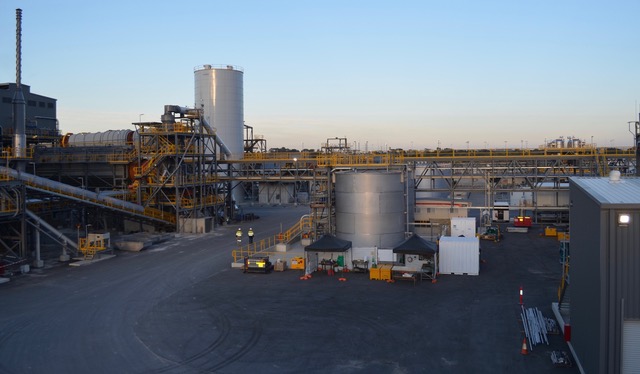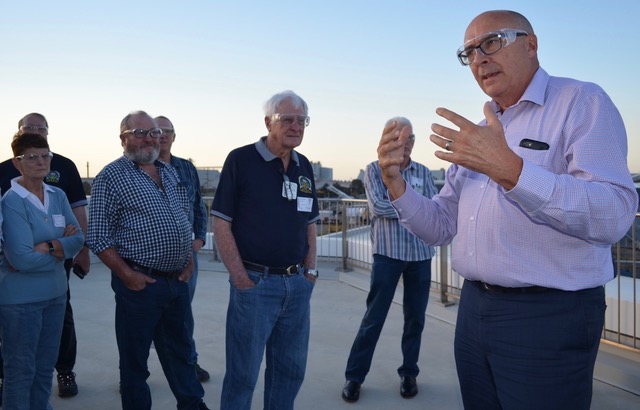
Tianqi Lithium Plant
TIANQI Lithium has spent more than $600 million so far on its Kwinana lithium hydroxide plant (already the world’s largest), the company’s Australian general manager Phil Thick told Palm Beach Rotarians on Wednesday night.
It will spend another $200 million before stage two is completed, he said.

Phil Thick with Palm Beach Members
And 85 per cent of that spend was with local suppliers. Only parts of the crystalliser were imported because the overseas manufacturer would not allow them to be made under licence in Australia.
But it was important to the company that as much as possible would be sourced locally, Mr Thick said.
He added that 80 per cent of the plant’s workers live within a 10-12 kilometre radius of the plant.
Work to get stage one into production by December is flat out. Tianqi Lithium Australia “took control of the whole plant only yesterday — so your visit is very timely,” he said.
Some processing of spodumene (lithium ore) is already taking place, though not to the final stage. The partially processed product is being stockpiled until the entire product chain is operational.
The highly-automated plant will have a permanent workforce of 200 and 180 are already in place. Product purity is vital but if people are involved in the 24/7 process they can mess it up. So “they don’t touch it,” he said. There are very few people “wandering around with a greasy rag and a spanner”.
The key to quality output is the lab technicians and that is where the remaining few job vacancies lie.
The club heard a rapid-fire explanation — punctuated by questions — of the exploding world demand for lithium hydroxide, which is used in rechargeable batteries.
In full production, stage one will output 24,000 tonnes a year.
Stage two, “an exact replica” of stage one, will produce the same amount.
Last year worldwide consumption of lithium hydroxide was just 40,000 tonnes. But it was predicted to grow at least ten-fold in the next six years, Mr Thick said. While Tianqi’s Kwinana plant was currently the world’s biggest, bigger ones were being built; for instance Albemarle’s Kemerton plant. Its stage one will produce 50,000 tonnes a year. “But they are two to two and a half years behind us,” he said.
And Tianqi has options on more land on two sides of the existing Kwinana plant for more production facilities.
“Tianqi is a Chinese company and one of the four biggest lithium producers in the world,” Mr Thick said. Two of the other leading producers are US-owned and the fourth is Chilean.
Tianqi also owns 51 per cent of Talison, which mines lithium at Greenbushes. Until four years ago, the Greenbushes operation produced 45 per cent of the world’s lithium ore .
Other mines have opened since but the Greenbushes ore has a higher concentration than that from other regions. Other deposits around the world are around one to 1.2 per cent, he said. “Greenbushes averages 2.5 per cent, it is a unique deposit in the world,” he added.
Greenbushes is the longest continuously operated mine in Australia, Mr Thick said. Tin mining began there in 1888 and tantalum mining followed in the 1940s. Tantalum is used in steel alloys and hi-tech electronic and aerospace industries but it is not worth as much as lithium. Greenbushes’ lithium operations began in 1983.
The company will sell direct to battery manufacturers such as LG Chemicals (Korea’s largest chemical company) and has just signed a contract with a Swedish company which is building a factory in an area where it gets free hydro power.
Tianqi Lithium Australia is striving to be an environmentally friendly as possible. Its power consumption is not over the top and all water is recycled.
For every eight tonnes of spodumene into the plant, one tonne of lithium hydroxide is produced. The waste will be sold to the concrete industry for paving materials. “We will re-use every tonne of by-product,” Mr Thick said.
European companies such as Volkswagen (currently rebuilding its reputation) and BMW wanted to buy from Australia, even though it might be more expensive than Asian plants, because of higher quality, reliability and highest ethical standards. Kwinana’s output will be second to none in quality and sold into a premium market.
Greenbushes had a 60 year life but this would reduce with recent and future expansions, Mr Thick said. Every car manufacturer wanted to get into lithium ion batteries now and it made sense to use the resource while it was needed.
It is expected that an alternative to lithium might emerge in the next 10 years. About that time there will also be a flood of lithium batteries at the end for their lives, and every country in the world was looking at battery recycling.